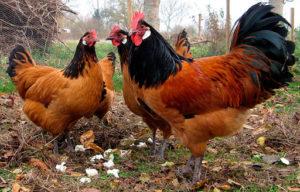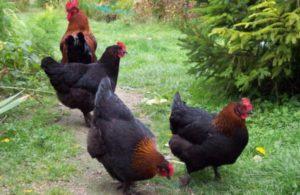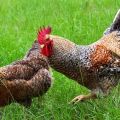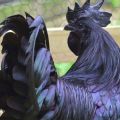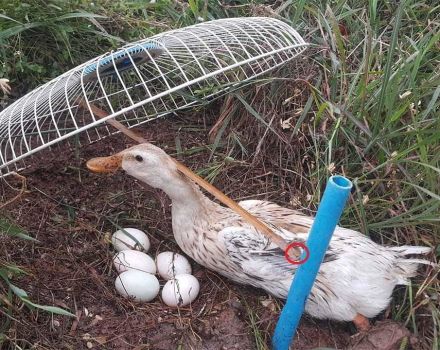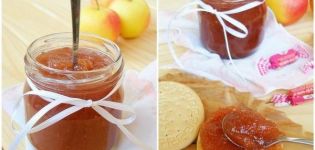Description and characteristics of the Rhodonite chicken breed, the subtleties of keeping and breeding
The prevalence of Rhodonite chickens is associated with their good egg production and adaptability to environmental conditions. Cross is suitable for breeding and keeping in private backyards and on an industrial scale.
Breeding history
Rhodonite chickens are considered an industrial cross, bred by crossing two egg crosses: Rhode Island and Loman Brown. German researchers began to engage in breeding, having received 2 strains. In 2002, the chickens entered the territory of Russia, where the research was continued by the employees of the Sverdlovsk pedigree poultry plant.
The task of the breeders was to breed chickens adapted to the changing climatic conditions of the country.
Description and characteristics of the Rhodonite breed
Cross Rhodonite has inherited the characteristics of both varieties used in crossing. When planning bird breeding, you should familiarize yourself with the detailed description and characteristics of the breed.
Appearance and color
Outwardly, most of the offspring are similar to the ancestors of the Loman Brown breed. Some chicks inherit the characteristics of the Rhode Island species. Rhodonite chickens are characterized by the following appearance features:
- small head with a large leaf-shaped scallop;
- the beak is yellow with an orange stripe in the central part;
- structured and well-developed red earrings;
- feathers of brown color tight to the body;
- light and simple body structure;
- the weight of chickens up to 2 kg, roosters - 3 kg.
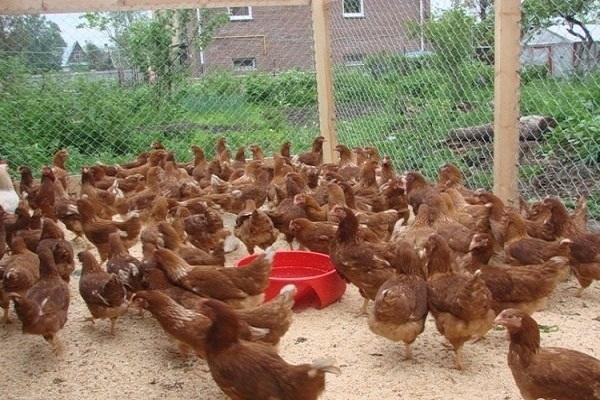
It is possible to distinguish layers from males at an early stage of development by characteristic features. In females, the circles are lighter, the fluff is brown, and the head and back are similar in color to baked milk.
Character and maternal instinct
Chickens are distinguished by their mobility and constant activity, while they do not show aggression towards other birds and people. Since the Rhodonite cross is the result of selection, the maternal instinct for incubation is almost completely lost. Breeding chicks requires an incubator.
Productivity
The first eggs of Rhodonite chickens begin to lay at the age of 4 months. During the year, each individual is able to bring about 300 eggs. The mass of each of them is 60-65 g.
After 1.5 years after the start of egg production, the productivity of layers is noticeably reduced. When keeping chickens in industrial poultry farms, this problem will be eliminated by using a special vaccine, which doubles the high level of productivity.
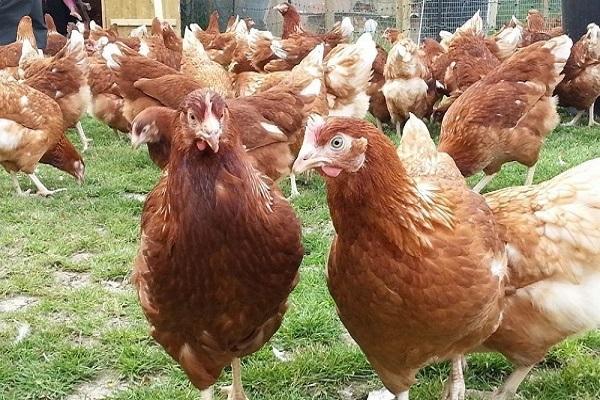
Main positive and negative aspects
Many novice and more experienced farmers are raising Rhodonite chickens due to its many benefits. The positive aspects include the following:
- Birds painlessly perceive the change in environmental conditions without loss of productivity. Even when exposed to low temperatures, chickens lay a sufficient number of eggs.
- Cross Rhodonite has a high survival rate for small and adults.
- Chickens are unpretentious to a nutritious diet. It should be borne in mind that the quality of eggs directly depends on proper feeding.
- You can breed chickens in small private farmsteads or in large poultry farms.
The main disadvantage is the underdeveloped incubation instinct. The use of incubation equipment does not present any particular difficulties, but increases the costs of the process of breeding offspring.

Conditions of detention
Despite the fact that Rhodonite chickens easily adapt to any environment, adults and young animals should create a favorable environment. This is especially important for laying hens, as the conditions of housing affect the ability to lay.
Chicken coop
Most of the time the birds spend in the chicken coop, which is recommended to be equipped taking into account the standard requirements. Ventilation must be provided inside the room to eliminate unpleasant odors and circulate fresh air. It is important that there are no gaps in the walls and roof, due to which through blowing can be observed.
The optimum height of the chicken coop is from 1.8 m. The temperature regime should vary between 15-25 degrees. Determine the free space in the room at the rate of 2 chickens per square. Places for roosts are located at a height of about 1 m. To prevent diseases, roosts and the floor are whitewashed. Baths with ash or sand are left inside the house.
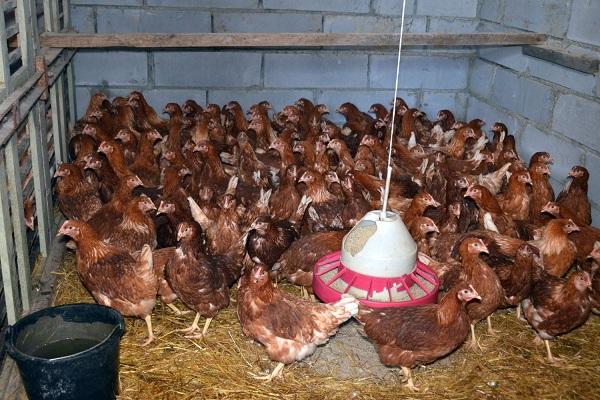
Walking yard
Next to the poultry house, you need to build a yard for walking chickens and fence it off. It is recommended to put a canopy inside the patio unless there are large trees nearby that cast sufficient shade. From above it is worth covering the courtyard with a net to protect against birds of prey.
Walking chickens is relevant for small and medium-sized livestock. The presence of vegetation in the yard allows you to save on feeding the birds, since they will independently find green food rich in vitamins. At the same time, most of the chickens usually walk near the poultry house, and the grass cover quickly grows down. The exit area should always be kept dry and disinfected to prevent chickens from introducing parasites and large amounts of dirt into the house.
You can release chickens outside around noon, when the main time for laying eggs passes. In cooler weather, it is best to limit access to your patio to reduce your risk of disease.
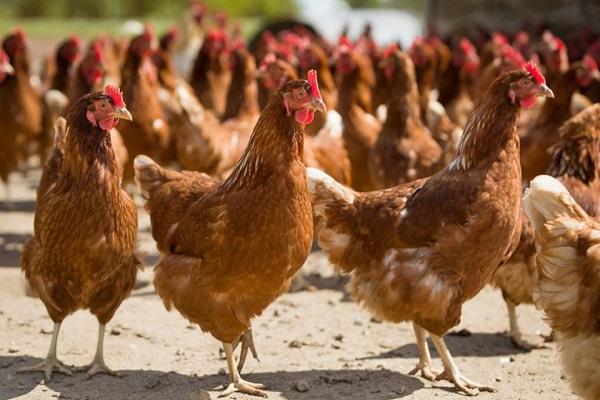
Tolerance to cold and heat
The ability to withstand extreme temperatures is one of the advantages of keeping Rhodonite chickens. Birds do not decrease their productivity when they are at low temperatures in an unheated room. In hot weather, it is enough for chickens to have a canopy under which they can hide in the shade.
Diet of chicks and adults
In the first weeks of chick development, special attention should be paid to nutrition. Juveniles should receive adequate amounts of calcium and vitamins. For feeding chickens, it is recommended to use special combined feed, which contains all the components necessary for proper growth. The lack of vitamins in chickens can be seen in the general depression. In adult males, the lack of nutrients leads to reddening of the comb.
For mature chickens, you can use compound feed or natural products in the same way as for chickens. Fruits, herbs, grated vegetables (cabbage, zucchini, pumpkin), cut grass are suitable for feeding chickens. Minerals play an important role in the diet. To improve egg production, you can include meat or fish broth in the diet. Wheat and corn grits can be used as dry food. Laying hens will benefit from the use of chalk and shell rock.
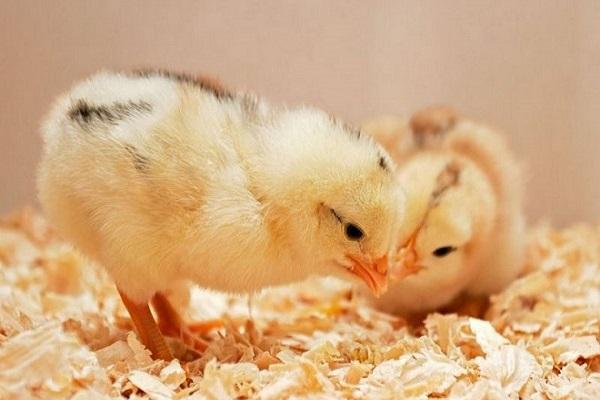
Breeding
Due to insufficiently developed maternal instinct, females do not hatch eggs on their own. To breed birds, an incubator is required. The presence of a rooster in a flock for breeding is not necessary, since the productivity of layers does not depend on this. The only reason it is worth having at least one rooster in a hen house is to keep the birds in order and protect the hens from possible danger.

Diseases and prevention from them
Any type of bird is susceptible to diseases that lead to a deterioration in egg production. The reasons for the development of infections are pollution in the chicken coop, an improperly composed diet and unfavorable conditions for keeping chickens. Chicks are most susceptible to diseases at the stage of early development. Common diseases are:
- Pullorosis. The infection affects chicks less than two weeks of age and is fatal. You can notice the development of pullorosis by the lack of appetite, lowered wings and closed eyes.
- Pasteurellosis. The disease is typical for chicks under three months old. Symptoms include mucous nasal discharge, overheating of the body, and yellow feces. Treatment for chickens involves the use of antibiotics under the supervision of a veterinarian.
- Coccidiosis. A symptom of the disease is frequent loose stools with blood or mucus due to damage to the gastric mucosa. For treatment, drugs with an anticoccidal effect are required. In the case of the acute phase of the disease, the death of chickens occurs after 3-5 days in the absence of treatment.
- Tuberculosis. Due to the disease, the lungs are most often affected. The sick bird stops laying eggs, loses its appetite and quickly loses weight. If the diagnosis is confirmed, the birds are sent to slaughter.
- Mycoplasmosis. The disease is manifested by the formation of a tumor under the eyes. In addition, infected birds make shrill, unusual noises. Mycoplasmosis leads to a decrease in egg production in chickens and is treated with special preparations "Tylosin" and "Tilan".

As a preventive measure, you need to keep the chicken coop clean and regularly carry out disinfection measures. Birds should be inspected periodically to detect early signs of disease. Having noticed the primary symptoms, you should start treatment on your own or seek help from veterinarians.
Where to buy and what are the prices?
It is recommended to purchase birds at proven factories, where a quality guarantee and a certificate of absence of diseases are provided. It is not difficult to find a cross of Rhodonite due to its high prevalence. The cost of adult birds varies between 200-300 rubles. Each owner of the poultry farm sets specific prices independently.
